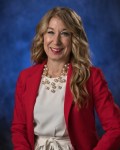When the pandemic hit the Ozarks in early 2020, Nicole Chilton was a Springfield career woman. Then the schools switched to virtual learning.
Chilton, who was serving as the director of marketing and development for the Springfield Regional Arts Council, had to shift gears.
She and her husband have two children, who were in fourth and second grade at the time.
Though she was able to work remotely in the beginning, balancing her job with her kids’ virtual schooling was incredibly difficult. She said she loved her career and her colleagues, and she desperately wanted to make it work.
“We didn’t know what the school situation was going to look like — consistency, learning and virtual versus in-person,” Chilton recalled. “I knew that the virtual situation wasn’t going to fit our family, my children’s personalities.”
On top of everything she was juggling, Chilton was writing a book at the time. When she became sick with an autoimmune issue, Chilton decided it was time to step away from her career with the Arts Council.
She suspects the autoimmune problem was brought on in part by all the stress.
“I piled on too much, I think,” Chilton said.
Chilton, who has a bachelor’s degree in journalism from the University of Missouri, homeschooled her kids during the 2020-2021 school year.
“It was a really positive experience,” she said. “I’m glad that we got to try it. I definitely went the unschooling route, where the curriculum was kind of — as we went along, if I found out they were super interested in learning about space, then we would watch a space documentary and check out space books and go on field trips around town that would amplify that.”
Although her kids decided to return to their regular school this year, Chilton is choosing to remain out of the workforce for the time being.
A ‘she-cession' in the works
She is not alone. Since the beginning of the pandemic, some 1.8 million women have left the workforce in what some economists call a “she-cession.”
According to the U.S. Bureau of Labor Statistics, the pandemic disproportionately impacted women, particularly mothers of young children. The adult women’s employment rate is at its lowest pre-pandemic level since September 1988.
While research by the McKinsey Global Institute found that women’s jobs were almost twice as vulnerable to the pandemic as men’s jobs, many women like Chilton made the decision to leave the workforce.
The McKinsey Global Institute also found that Missouri could grow its economy by 10 to 15 percent by 2025 if women’s participation in the workforce increased.

Missouri State University economics professor David Mitchell cautioned that while these types of GDP stats are accurate, they don’t paint a complete picture of what’s happening.
“GDP is measured by the number of market transactions that actually occur,” Mitchell said. “So if I hire somebody else to raise my child, that raises GDP. If I don’t hire somebody else to raise my child and I raise him myself, GDP doesn’t go up. But that still doesn’t change the fact that the child is being raised.
“With women leaving the workforce, is the GDP going to be smaller? Yeah, it just is. There’s no doubt about that,” he continued. “Does that mean people are worse off? That’s debatable.”
For many women, the struggle to find child care during the pandemic led to their exodus. Others, like Chilton, reevaluated what’s important in their life and made the decision to stay home to homeschool or pursue other interests.
In Chilton’s situation, it didn’t make financial sense for her husband, who makes more money, to step back from his career to homeschool the children.
“So many women were affected by (the pandemic) just because of the income disparity between men and women,” she said. “It just made more sense for a lot of women to step back.
“I am so grateful that I have the opportunity and accessibility to be able to step away from the workforce during the pandemic,” Chilton added. “I know not everyone is able to do so and it has been a struggle.”
Sue Cupka Head also stepped away from her career during the pandemic. The licensed clinical social worker says she has no plans to return full time anytime soon. She is currently working part time and remotely for Missouri State University’s Master’s of Social Work program.
Cupka Head has a Master of Social Work degree, as well as a Master of Public Administration, with a concentration on non-profits. She has about 15 years experience in non-profits and the mental health field.
When the pandemic hit, she was a private therapist working one-on-one with patients.
Initially, Cupka Head tried switching to providing therapy to her patients via telehealth, and her children, then ages 9 and 5, attended school virtually.
Virtual school was difficult, particularly for the then-second grader. And providing therapy via telehealth was a “struggle,” she said, adding that therapists are unable to pick up on all of the body language cues or get a chance to meet family members.
Once they made it to summer break in 2020, the family decided to switch to homeschooling and Cupka Head quit her job.
“I was the parent in my family who scheduled every single vaccine appointment for each family member. I coordinated homeschooling, curbside pickups for groceries and household items, dinners out, and the like,” Cupka Head said. “I believe women were the primary folks in our society who had to take crash courses on moving life online as soon as we could in order to keep our families safe.”

She said her husband would have loved to have been the one to quit his job and take over homeschooling. But as an archeologist who at the time did surveys for sites being constructed with government funds, her husband was considered an “essential worker.”
“In my marriage and in my family, we have always tried our best to be equitable with each other. We gave each other our last names,” she said. “We really have tried to make this situation equitable for us, but I know that is not the most common situation for women.”
Even though her husband was open to the idea of him staying home with the kids, Cupka Head described herself as someone who was very susceptible to catching viruses pre-pandemic. For that reason, she chose to step away from the workforce.
For Cupka Head, the idea of returning to private practice and being face-to-face with patients again during the pandemic “seems absolutely impossible at this point.”
“It would take buy-in from the part of society that does not believe in vaccines and does not believe that the virus is as potentially dangerous as it is,” Cupka Head said. “I just don’t know if there will be that single kicker that will make me feel: ‘Okay, now it’s fine.’”
The long-term effects of dropping out of the workforce
While both Cupka Head and Chilton are comfortable with their decisions to remain out of the workforce for now, some worry about the long-term impacts of this pandemic-induced “she-cession.”
Will their positions still be there if and when the women decide to return to the workforce? How does this impact the significant strides women have made in the workforce over the past 30 years?

These are serious concerns to Wendy Doyle, President and CEO of United We, a nonprofit that serves the state of Missouri and works to advance all women’s economic and civil leadership.
“Women were really progressing more into management positions within the companies and even into the executive level,” Doyle said. “We were seeing more women being invited to join corporate boards. We were seeing more women wanting to participate in and have good civic participation and running for elected office.
“But as a result of the pandemic,” she continued, “women are dropping out of the workforce.”
Sally Payne, Springfield’s Director of Workforce Development, echoed those concerns.

“Many women were forced to drop out of the workforce early on in the pandemic when schools went virtual and they needed to be home with their children,” Payne said. “At that same time, the pandemic caused a lot of child care facilities for babies and toddlers to shut down either for good or temporarily — which also led to women having to leave their jobs to take care of children.”
“I think some thought it would get better back in September when schools started, but that hasn’t materialized yet. Certainly, the Delta variant hasn’t been helpful as well as the Omicron Variant,” she said in an email following the interview. “I think we are still waiting on that comeback and look forward to it since women contribute so greatly to the workforce.”
Payne worries those same jobs once occupied by women pre-pandemic won’t be there waiting for them if they wait a few years to return to the workforce.
“The reality is for an individual woman who was making gains in her career, climbing up that ladder,” she said, “to stop that right in the middle, stay home, which I would never criticize that, but will they be able to reenter at the rate that they left? Their spots aren’t getting held, right? They have to be refilled.”
Mitchell, the MSU economist, said women have to figure out for themselves if it’s worth it to step away from their careers to care for their children. There are benefits to parents being the ones who look after their children as opposed to strangers, he said.
“The problem is that when they do that — and I’m not saying that that’s a good thing or a bad thing,” he said, “when you are out and you come back in, the skillset that you’re building by working gets eroded.”
Not only can it be difficult to return to the workforce because of diminished skill sets, Mitchell said it’s likely they will be making less money than if they had stayed in the workforce.
He shared that his own wife chose to leave the workforce years ago to take care of their three children. She has a master’s degree and can teach kindergarten through 12th grade. But when they did the math, they realized if they paid for child care out of her salary, she’d be taking home about $1.50 an hour.
After nearly 10 years at home with the kids, Mitchell said his wife had a hard time getting back into the workforce for that very reason: her skill sets had eroded somewhat.
“Just going to the office, showing up on time and being collegial with colleagues — that doesn’t seem like the biggest skill set,” Mitchell said. “But it really is those what we call soft skills.”
‘Child care was always a barrier’
By all accounts, the lack of child care is a primary reason why so many women left the workforce. Throughout the pandemic, many child care facilities have either had to close for good or at least shut down for a time. And those that remain in business continue to be plagued by the virus, often having to shut down classrooms and quarantine staff and children.
“We just simply didn’t have enough (child care spots) pre-COVID,” Payne said. “And we certainly don’t have enough post-COVID.”
Greene County lost more than 700 licensed child care spots since the start of the pandemic, according to the Community Focus Report.
“Child care was always a barrier to employment pre-COVID,” Payne said. “So what are you going to do? I mean, you have to make the decision: what are you going to do with your child?”
Lack of eldercare, too, led many women to leave the workforce, Payne said.
“Women — and I’m not saying all, but the majority — are just caregivers in general,” she said, “not just for children, but for aging parents or family members.
It’s not just the pandemic’s impacts on child care and eldercare that have hindered some women from remaining in the workforce. Supply chain issues created some surprising challenges, Payne said.
The diaper shortage, for example, became a huge barrier for many moms of babies because parents are required to supply a certain number of diapers for their babies each day. And by law, child care providers are required to change the baby’s diapers so many times a day. If the parent can’t provide diapers, they cannot leave their child at the facility.
“So even diapers are a barrier to sending your child for child care during this time,” Payne said. “You wouldn’t think it would go down to such a micro-level, but it really does.”
Locally, Payne pointed to Springfield Public Schools’ new staggered start and end times as being a huge barrier for women who want to stay or get back into the workforce. Beginning this school year, some schools are from 7:30 a.m. to 2:30 p.m., others go from 8:30 a.m. to 3:30 p.m., and some go from 9:30 a.m. to 4:30 p.m.
SPS made these schedule changes to accommodate more time for buses to pick up students. That change happened after the school expanded bus-riding eligibility for high school students who live at least 1.5 miles away rather than the former 3.5 miles away from school.
Payne said she understands why school administration had to make the changes, and she is not criticizing SPS.
“But it did have an effect,” she said. “When your child doesn’t get on the bus until 8:30 in the morning and you have to be (at work) at 9 o’clock in the morning, if your employer is not flexible or doesn’t have the ability to be flexible, what are you going to do?”
And the life-altering chaos of the pandemic, in general, caused many people to reevaluate their lives and their careers. Not only are some couples considering whether or not they can make it on one paycheck, so the other — usually the woman — can stay home and take care of the children, but there’s been an “uptick in entrepreneurialism,” Payne said.
“People are choosing to open their own business because they’ve got the control. They can set their own hours. They can remote work.”
What companies can do
According to Payne, about 70 percent of people who left the workforce during the pandemic are not planning to return to their old jobs. They are searching for a new job and say workplace culture and flexibility are among their main concerns.
“They want to work for a place (where) they feel valued and important. They are looking for that culture,” Payne said. “Which makes it even more challenging for employers. I mean, they’ve done a great job at moving their wages up. They’re doing everything they can as far as money. But then they’re also have to look at the culture of their organization because, frankly, job seekers hold all the cards right now.”
Payne encourages employers to consider offering more flexible work schedules that allow parents — not just women — to be able to get their kids to and from school or child care, as well as remote-work options, particularly for those who might have a child who is sick or needing to quarantine from school.
Companies should also consider offering more mental health support for women, Payne said.
“There’s a lot of stress and anxiety that goes along with all the burdens that women are shouldering right now, being caregivers, making those decisions, trying to work,” she said. “That’s stressful on a mother anyway — and I’ll speak to that — but I can’t imagine especially single mothers.”
Chilton, the former marketing director, doesn’t plan to stay out of the workforce permanently. But she’s taking her time and will be pretty choosy when it comes time for her next job search.
The flexibility to be able to work remotely when needed is her top priority. The Daily Citizen spoke to Chilton during a time in January when Springfield Public Schools moved learning back to virtual for a week.
“I feel more comfortable being home to just monitor that they’re staying on top of everything,” she said. “That’s my number one.”
Ready to go back to work? Here’s help:
All services at the center are free at the Missouri Job Center, where the City of Springfield, Missouri's Department of Workforce Development is housed.
It's located at 2900 E. Sunshine, with satellite offices at 1126 N. Broadway inside The Fairbanks Community Hub, and 2720 Shepherd of the Hills Expressway in Branson.
The center exists to connect people with jobs and help bolster the local workforce through short-term trainings, workshops and job connections, the website says.
The Job Center serves a seven-county Ozark Region, encompassing Greene, Christian Dallas, Polk, Stone, Taney and Webster counties in southwest Missouri.
“All of the jobs listed in our online job system, MoJobs, are vetted. We vet the employer. We vet the job,” Payne said. “We don’t sell the information, so there’s a trust factor with our jobs within our job system that isn’t out there on the open markets. We’re very proud of that.”
In addition to helping connect workers with potential employers, the folks at the Missouri Job Center know what type of keywords and phrases catch employers’ attention and are happy to help with resumes.
“I don’t think we talk about the importance of a resume enough. So we really, really stress a strong resume here,” Payne said. “And I think that’s something that we do very well.”
If a woman (or man) chose to leave the workforce during the pandemic to take care of children or family members, Payne said it’s important to include that on their resume and to explain it in a positive way.
“For example, if a woman has had to sit out of work for the last two years, we shouldn’t discount what she’s accomplished during that two-year time,” Payne said. “A lot of people don’t want to put that on a resume because it makes them look like ‘What have I been doing for two years?’ But we can take that and we can point out the importance of that time away or the strength of that.”
Another resume-related area where the folks at the Job Center can assist is with what Payne referred to as the “hidden workforce.” These are resumes that people submit online and are then overlooked by automated human resources systems due to decorative graphics or other styling no-nos.
“A lot of people who put cute lines or pretty graphics, (their resumes) aren’t recognized,” Payne said. “They’ll just get rejected for the graphics. And I don’t think people realize the simpler, the better.
“We can also do mock interviews with people to get them comfortable getting back out there again. There’s a lot of anxiety that goes with interviewing,” Payne said. “And if you’ve been out for a while, I think a lot of people are fearful about how do I talk about that? How do I talk about my time away and what I did? And we stress the value in it and the strength of it.”
It’s important that anyone who made the decision to leave the workforce during the pandemic to not have reservations about that when trying to find a new job, Payne said.
“Own it. Be proud of it,” she said. “You made a very tough decision, and it’s all in how you present that. And we focus on your strengths.”
The center also has a computer resource area for job searches, phone and fax machines, setup for virtual interviews, the Career Closet and a staff of Workforce Development Specialists who can help guide you through our job search engine MoJobs.
The center often hosts on-site hiring events with multiple employers, both indoor and outdoor, as weather permits.
Learn more about the center and what jobs are available at jobs.mo.gov.

